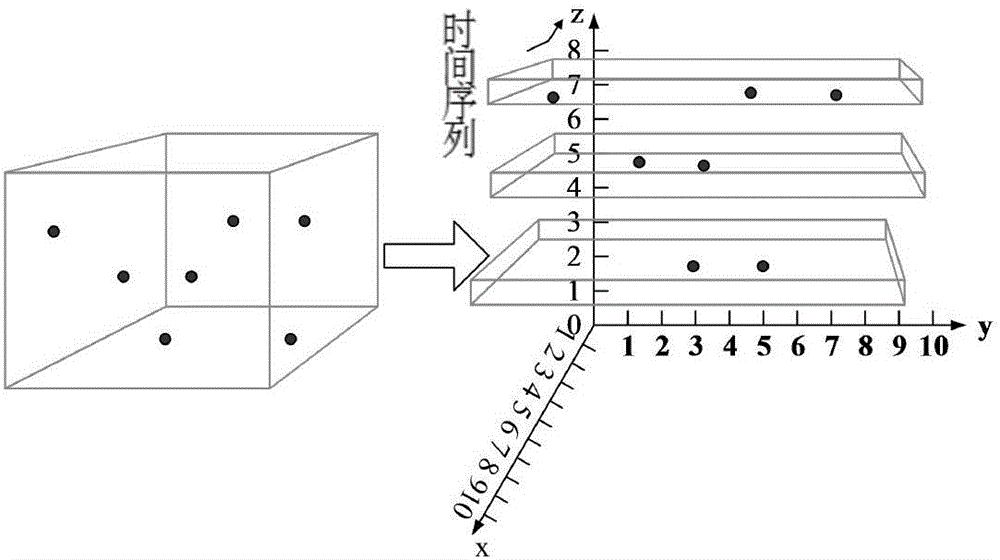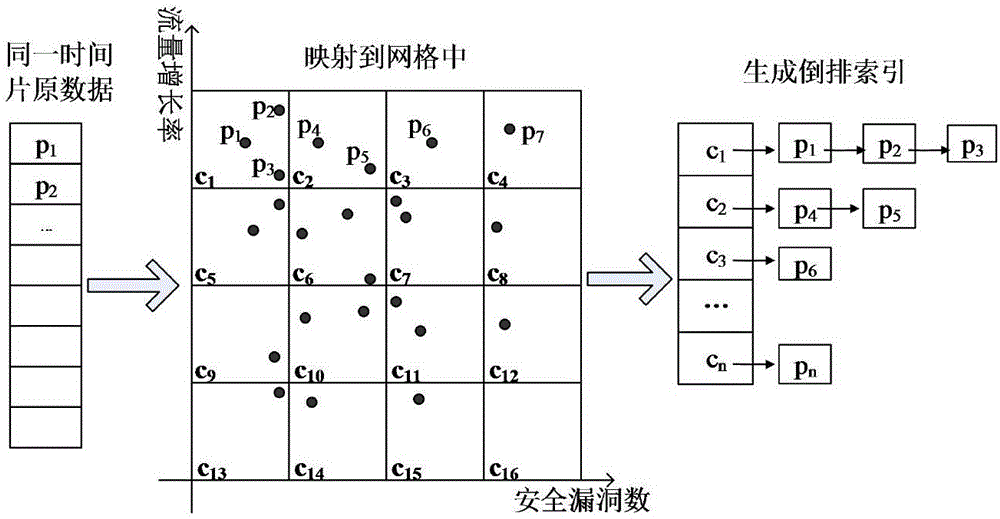Spatial time sequence data stream application-based Skyline query method
A query method and data flow technology, applied in the field of Skyline's query system, can solve problems such as poor universality and poor scalability
- Summary
- Abstract
- Description
- Claims
- Application Information
AI Technical Summary
Problems solved by technology
Method used
Image
Examples
Embodiment 1
[0032] A skyline query system based on space time series data stream applications. Invention steps are as follows:
[0033] S1: Based on space timing division:
[0034] We will split the continuous time series into time slices by time windows. Such as figure 1 As shown, the method is as follows: Given a set of objects P, each data point p k The time attribute value (t) in a bounded interval [T min , T max ], construct a uniform partition {t 0 ,...,t B},t i Definition:
[0035] t i =T min +l×i, l=(T max -T min ) / B,i=0,...,B;
[0036] to form a set of time slices {b 0 ,...,b B-1}, each time slice b i =[t i ,t i+1 ), with a fixed length l. The time attribute value of each point is mapped to time slice b s(t) ∈{b 0 ,...,b B-1}, where s(t) is defined as B is the number of evenly divided bounded intervals.
[0037] The value of the interval fixed length (l) of different granularities depends on the actual application situation. In order to reduce the amount...
Embodiment 2
[0054] This embodiment relates to the specific application of the Skyline query method based on the spatial time series data stream application described in Embodiment 1:
[0055] The skyline query system based on the space time series data flow application is used for mobile medical calls. The cloud center service system provides spatial grid pruning strategies and continuous network medical data monitoring to execute dynamic Skyline and global Skyline algorithms, and input the thresholds of each attribute And the query result is sent according to the end of the execution time to improve the attributes of the hospital. That is, the system performs the following steps:
[0056] S1. The cloud center service system provides module index data structures with distributed dynamic Skyline and global Skyline algorithms. At the same time, we use the Spark streaming system to start multiple Maps to read time stream data, and each Map reads different HDFS data. Fragments generate data ...
Embodiment 3
[0059] The skyline query method based on the space time series data stream application in Example 1 is used for epidemic detection. First, we will divide the time series of epidemic monitoring into several time segments according to the time window, and then perform Skyline query on the data of each time segment. Static query. For the time object set P when the epidemic occurs, each data point p k The time attribute value (t) in a bounded interval [T min , T max ], construct a uniform partition {t 0 ,...,t B},t i The definition of t i =T min +l×i, l=(T max -T min ) / B, i=0, . . . , B. Form a collection of time slices {b 0 ,...,b B-1}, each time slice b i =[t i ,t i+1 ), with a fixed length l. The time attribute value of each point is mapped to time slice b s(t) ∈{b 0 ,...,b B-1}, where s(t) is as Among them, the value of interval (l) of different particle sizes depends on the actual monitoring time. At the same time, in order to reduce the amount of calcula...
PUM
 Login to View More
Login to View More Abstract
Description
Claims
Application Information
 Login to View More
Login to View More - R&D
- Intellectual Property
- Life Sciences
- Materials
- Tech Scout
- Unparalleled Data Quality
- Higher Quality Content
- 60% Fewer Hallucinations
Browse by: Latest US Patents, China's latest patents, Technical Efficacy Thesaurus, Application Domain, Technology Topic, Popular Technical Reports.
© 2025 PatSnap. All rights reserved.Legal|Privacy policy|Modern Slavery Act Transparency Statement|Sitemap|About US| Contact US: help@patsnap.com



